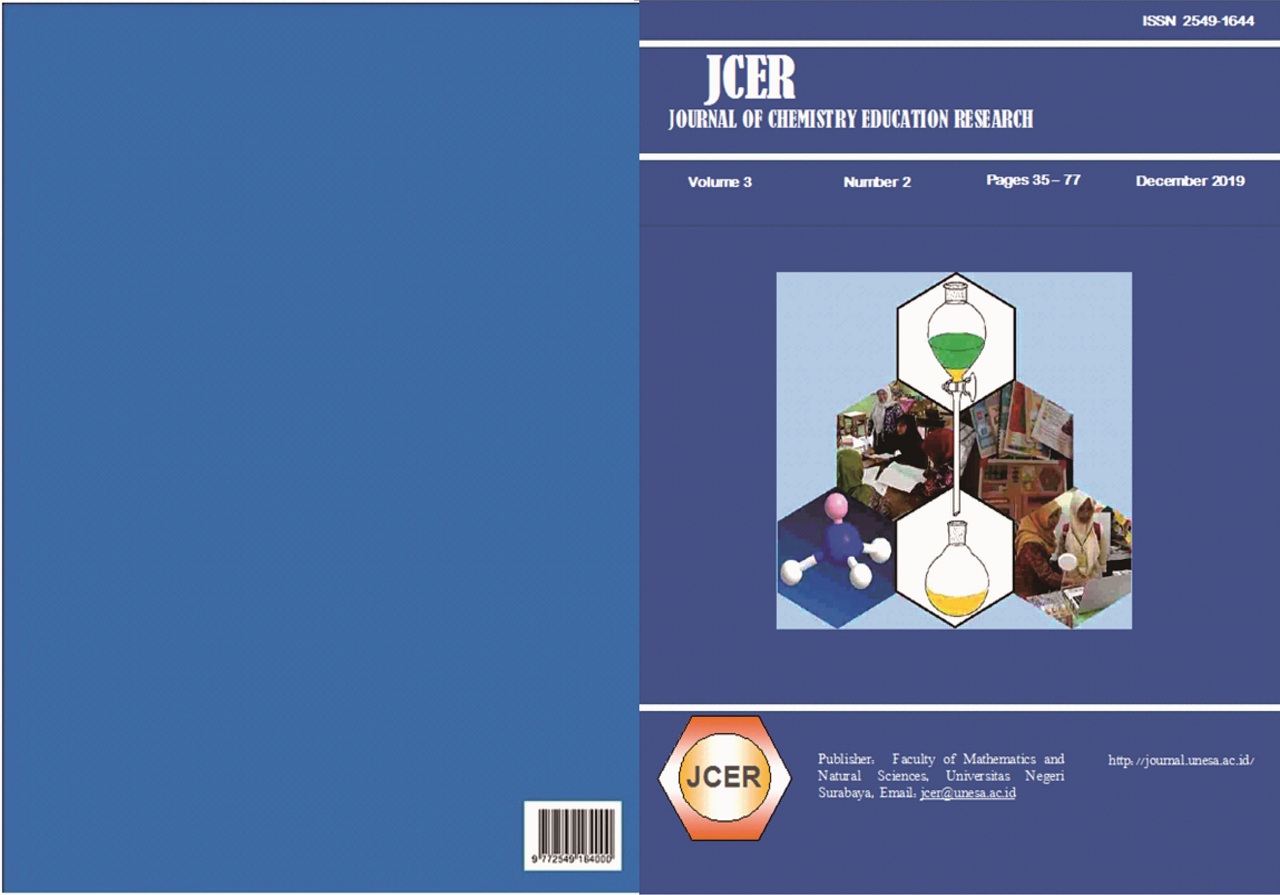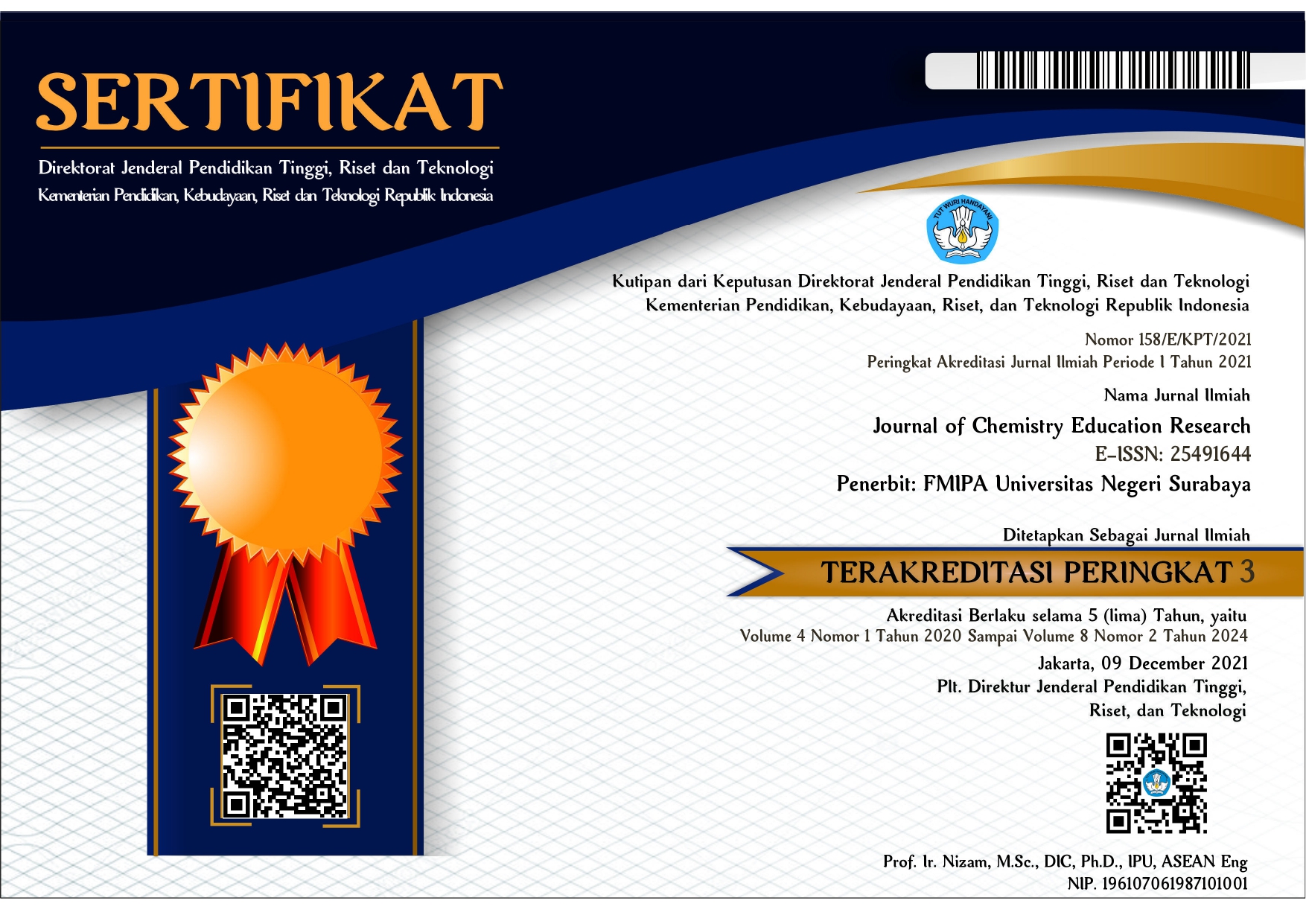THE EFFECTIVENESS OF PRACTICUM KIT AS A LEARNING MEDIA TO TRAIN SPS ON REACTION LAW
DOI:
https://doi.org/10.26740/jcer.v3n2.p35-41Keywords:
Practical KIT, Science Process Skills, Reaction Rate Law, EffectivenessAbstract
This study aims to produce the Practical KIT along with its devices that are effectively used as learning media to train students SPS on the sub material of the Reaction Rate Law. The method used in this study is Research and Development design. The research instrument used consisted of a sheet of pre-test and post-test. Data analysis was carried out in descriptive quantitative to determine the effectiveness of Practical KIT along with the devices developed. The media is said to be effective if it meets 2 requirements, namely the percentage of classical completeness <85% and N-gain value <0.3. The developed media has been declared effective as indicated by the increase in the value of cognitive learning outcomes in the "Medium" and "High" categories with 100% classical completeness, an increase in the value of science process skills of students after using the Practical KIT media. "With classical completeness reaching 91.67%.References
<p>[1] Afiyanti, N. A. (2013). <em>Efektivitas Inkuiri Terbimbing Berorientasi Green Chemistry Terhadap Keterampilan Proses Sains Dan Kepedulian Lingkungan Siswa SMA 13 Semarang Materi Kelarutan Dan Hasil Kali Kelarutan.</em> Semarang: Universitas Negeri Semarang.</p><p>[2] Permendikbud, N. 2. (2016). <em>Standar Proses Pendidikan Dasar dan Menengah.</em> Jakarta: Kementerian Pendidikan dan Kebudayaan.</p><p>[3] Kheng, Y. T. (2008). <em>Science Process Skill Form 1.</em> Selangor Dahrul Ehsan: Pearson Sdn. Bhd.</p><p>[4] Abungu, H. E., Okere, M. I., & Wachanga, S. W. (2014). The Effect of Science Process Skills Teaching Approach on Secondary School Students Achievement in Chemistry in Nyando District, Kenya. <em>Journal of Educational and Social Research, 4(6) </em>, pp. 359-372.</p><p>[5] Hofstein, A., & Lunetta, V. N. (2003). The laboratory in science education: Foundations for the twentyfirst century. <em>Science Education, 88(1)</em>, pp. 28-54.</p><p>[6] Koretsky, M. D., Christine, K., & Gummer, E. (2011). Student Perceptions of Learning in the Laboratory: Comparison of IndustriallySituated Virtual Laboratories to Capstone Physical Laboratories. <em>Journal of Engineering Education, 100(3)</em>, pp. 540573.</p><p>[7] Budianto, D. P. (2016). <em>Pengembangan KIT Penentuan Pengaruh Katalis Terhadap Laju Reaksi Secara Kuantitatif.</em> Lampung: Fakultas Keguruan dan Ilmu Pendidikan Universitas Negeri Lampung.</p><p>[8] Plomp, T., & Nieveen, N. (2013). <em>Educational Design Research - Part A: An Introduction.</em> Enschede: Netherlands Institute for Curriculum Development (SLO).</p><p>[9] Sugiyono. (2015). <em>Metode Penelitian Pendidikan (Pendekatan Kuantitatif, Kualitatif, Kuantitatif, dan R&D).</em> Bandung: Alfabeta.</p><p>[10] Agustini, R., Muchlis, Nasrudin, H., & Azizah, U. (2016). <em>Asesmen</em>. Surabaya: Unesa Press.</p><p>[11] Kardinata, R., & Abdurahman, M. (2012). <em>Dasar-dasar Statistik Pendidikan.</em> Bandung: CV Pustaka Setia.</p><p>[12] Hake, R. R. (1999). <em>Analyzing Change / N-gain Scores.</em> http://www.physics.indiana.edu/~sdi/AnalyzingChange-N-gain.pdf, diakses tanggal 1 Oktober 2017.</p><p>[13] Kementerian Pendidikan dan Kebudayaan. (2016). <em>Silabus Mata Pelajaran Sekolah Menengah Atas/Madrasah Aliyah (SMA/MA) Mata Pelajaran Kimia.</em> Jakarta: Kementerian Pendidikan dan Kebudayaan.</p>[14] Kementerian Pendidikan dan Kebudayaan. (2017). <em>Panduan Penilaian oleh Pendidik dan Satuan Pendidikan untuk Sekolah Menengah</em>. Jakarta: Kementerian Pendidikan dan Kebudayaan.
Downloads
Additional Files
Published
2019-12-31
Issue
Section
Articles
 Abstract views: 394
,
Abstract views: 394
, PDF Downloads: 384
,
PDF Downloads: 384
, PDF Downloads: 0
PDF Downloads: 0



